Python: Circular shift number
Python Programming Puzzles: Exercise-65 with Solution
Write a Python program to shift the decimal digits n places to the left, wrapping the extra digits around. If shift > the number of digits of n, reverse the string.
Input: n = 12345 and shift = 1 Output: Result = 23451 Input: n = 12345 and shift = 2 Output: Result = 34512 Input: n = 12345 and shift = 3 Output: Result = 45123 Input: n = 12345 and shift = 5 Output: Result = 12345 Input: n = 12345 and shift = 6 Output: Result = 54321
Pictorial Presentation:
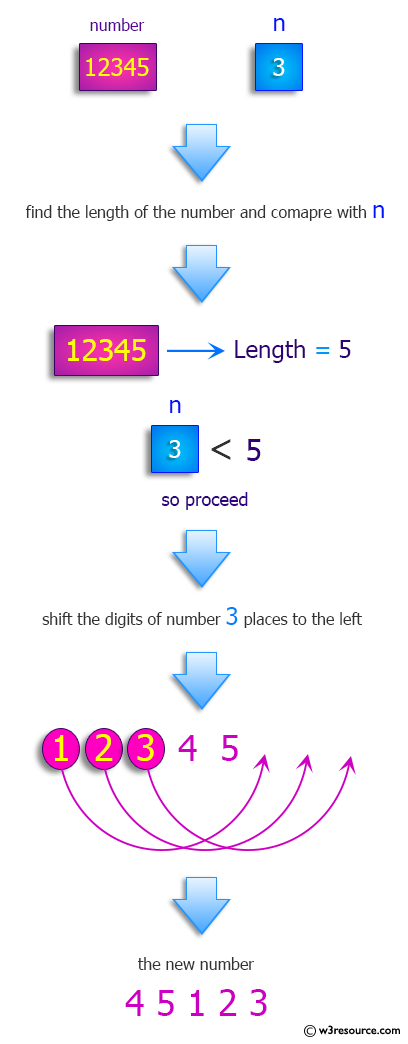
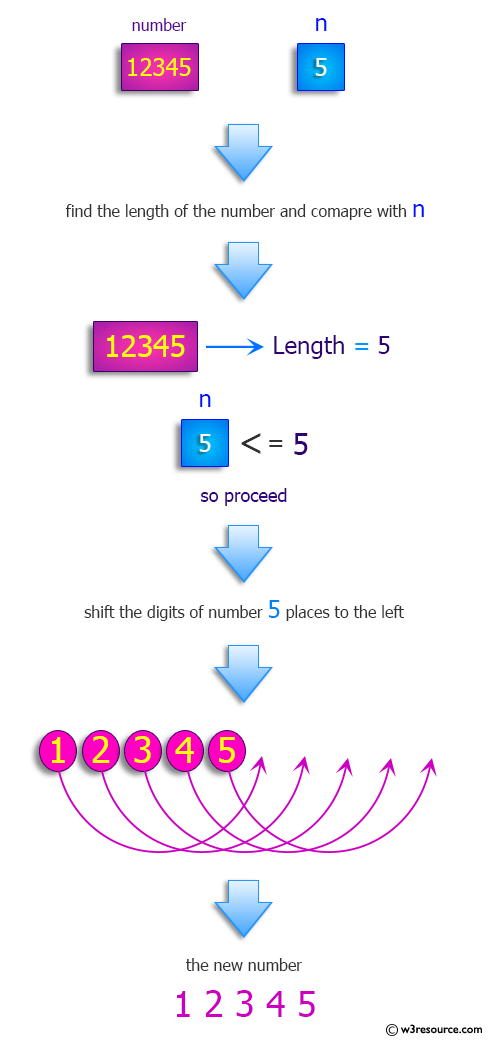
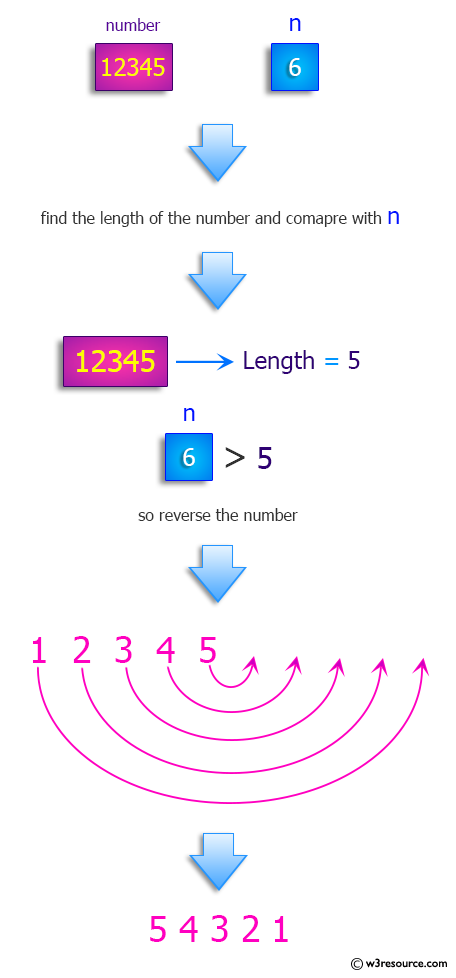
Sample Solution-1:
Python Code:
#License: https://bit.ly/3oLErEI
def test(n, shift):
s = str(n)
if shift > len(s):
return s[::-1]
return s[shift:] + s[:shift]
print("Shift the decimal digits n places to the left. If shift > the number of digits of n, reverse the string.:")
n = 12345
shift = 1
print("\nn =",n," and shift =",shift)
print("Result = ",test(n, shift))
n = 12345
shift = 2
print("\nn =",n," and shift =",shift)
print("Result = ",test(n, shift))
n = 12345
shift = 3
print("\nn =",n," and shift =",shift)
print("Result = ",test(n, shift))
n = 12345
shift = 5
print("\nn =",n," and shift =",shift)
print("Result = ",test(n, shift))
n = 12345
shift = 6
print("\nn =",n," and shift =",shift)
print("Result = ",test(n, shift))
Sample Output:
Shift the decimal digits n places to the left. If shift > the number of digits of n, reverse the string.: n = 12345 and shift = 1 Result = 23451 n = 12345 and shift = 2 Result = 34512 n = 12345 and shift = 3 Result = 45123 n = 12345 and shift = 5 Result = 12345 n = 12345 and shift = 6 Result = 54321
Flowchart:
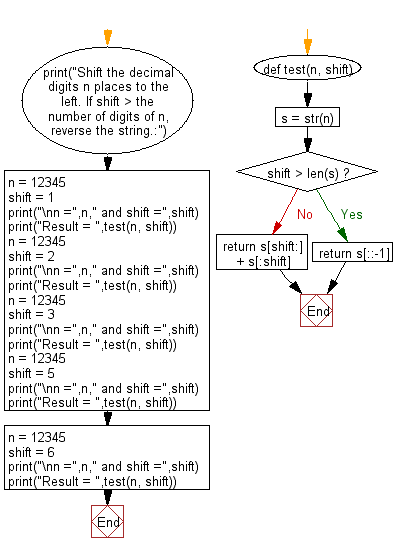
Visualize Python code execution:
The following tool visualize what the computer is doing step-by-step as it executes the said program:
Sample Solution-2:
Python Code:
#License: https://bit.ly/3oLErEI
def test(n, shift):
shifted_digits = [int(x) for x in str(n)]
for i in range(shift):
shifted_digits.append(shifted_digits.pop(0))
if shift > len(shifted_digits):
return str(n)[::-1]
else:
return ''.join(str(x) for x in shifted_digits)
print("Shift the decimal digits n places to the left. If shift > the number of digits of n, reverse the string.:")
n = 12345
shift = 1
print("\nn =",n," and shift =",shift)
print("Result = ",test(n, shift))
n = 12345
shift = 2
print("\nn =",n," and shift =",shift)
print("Result = ",test(n, shift))
n = 12345
shift = 3
print("\nn =",n," and shift =",shift)
print("Result = ",test(n, shift))
n = 12345
shift = 5
print("\nn =",n," and shift =",shift)
print("Result = ",test(n, shift))
n = 12345
shift = 6
print("\nn =",n," and shift =",shift)
print("Result = ",test(n, shift))
Sample Output:
Shift the decimal digits n places to the left. If shift > the number of digits of n, reverse the string.: n = 12345 and shift = 1 Result = 23451 n = 12345 and shift = 2 Result = 34512 n = 12345 and shift = 3 Result = 45123 n = 12345 and shift = 5 Result = 12345 n = 12345 and shift = 6 Result = 54321
Flowchart:
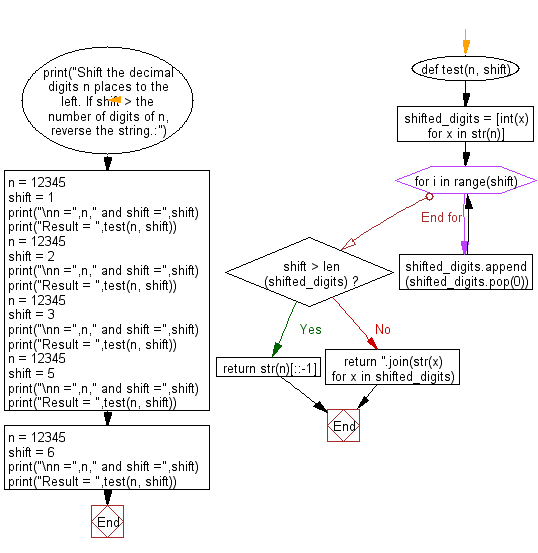
Visualize Python code execution:
The following tool visualize what the computer is doing step-by-step as it executes the said program:
Python Code Editor :
Have another way to solve this solution? Contribute your code (and comments) through Disqus.
Previous: Find the string consisting of all the words whose lengths are prime numbers.
Next: Find the indices of the closest pair from given a list of numbers.
What is the difficulty level of this exercise?
Test your Programming skills with w3resource's quiz.
Python: Tips of the Day
Find current directory and file's directory:
To get the full path to the directory a Python file is contained in, write this in that file:
import os dir_path = os.path.dirname(os.path.realpath(__file__))
(Note that the incantation above won't work if you've already used os.chdir() to change your current working directory, since the value of the __file__ constant is relative to the current working directory and is not changed by an os.chdir() call.)
To get the current working directory use
import os cwd = os.getcwd()
Documentation references for the modules, constants and functions used above:
- The os and os.path modules.
- The __file__ constant
- os.path.realpath(path) (returns "the canonical path of the specified filename, eliminating any symbolic links encountered in the path")
- os.path.dirname(path) (returns "the directory name of pathname path")
- os.getcwd() (returns "a string representing the current working directory")
- os.chdir(path) ("change the current working directory to path")
Ref: https://bit.ly/3fy0R6m
- New Content published on w3resource:
- HTML-CSS Practical: Exercises, Practice, Solution
- Java Regular Expression: Exercises, Practice, Solution
- Scala Programming Exercises, Practice, Solution
- Python Itertools exercises
- Python Numpy exercises
- Python GeoPy Package exercises
- Python Pandas exercises
- Python nltk exercises
- Python BeautifulSoup exercises
- Form Template
- Composer - PHP Package Manager
- PHPUnit - PHP Testing
- Laravel - PHP Framework
- Angular - JavaScript Framework
- Vue - JavaScript Framework
- Jest - JavaScript Testing Framework
